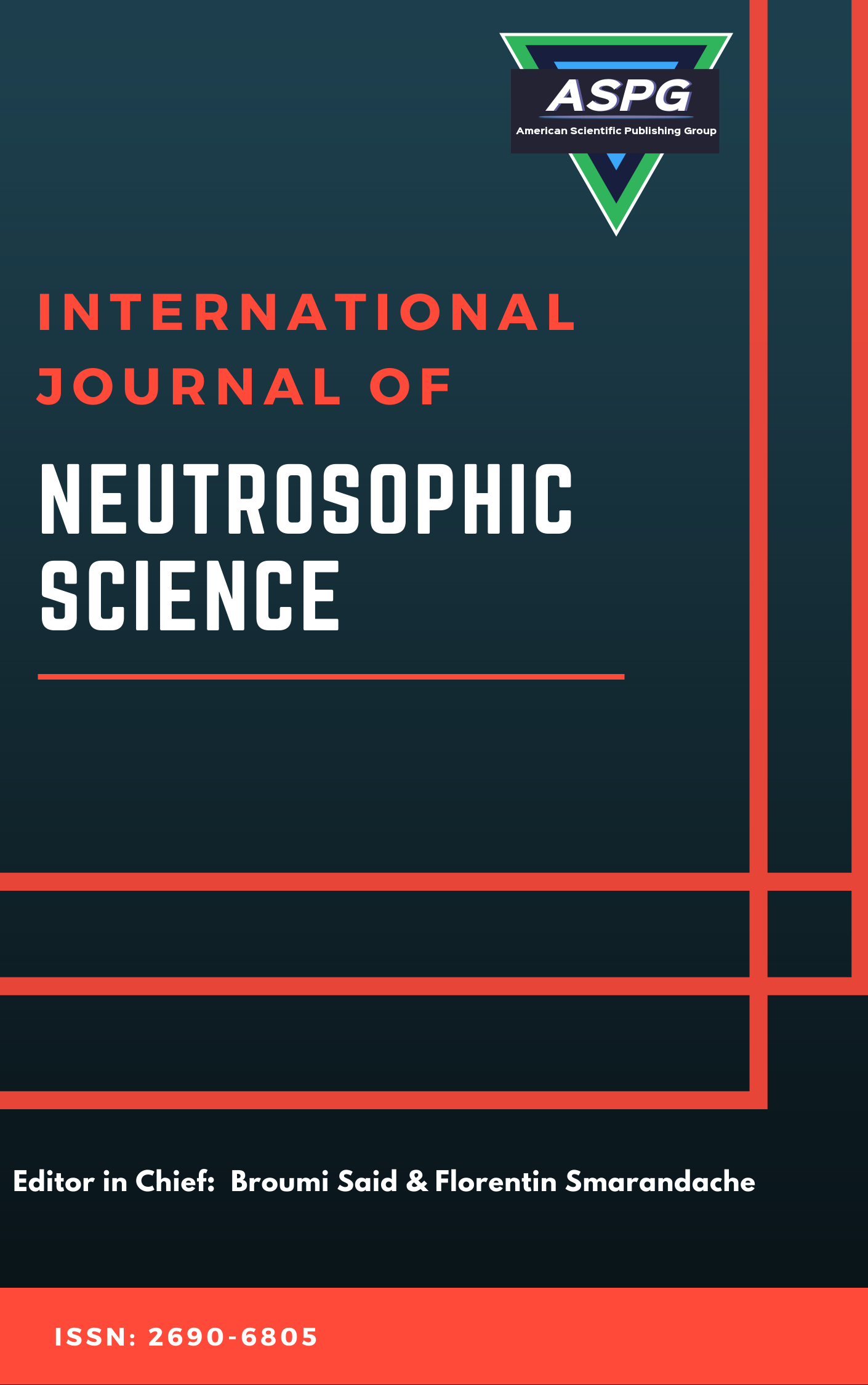

Volume 26 , Issue 4 , PP: 298-308, 2025 | Cite this article as | XML | Html | PDF | Full Length Article
Oscar José Alejo Machado 1 * , Adriana María Estupiñán Sera 2 , Maikel Y. Leyva Vazquez 3 , Florentin Smarandache 4
Doi: https://doi.org/10.54216/IJNS.260426
This work presents a neutrosophic stance detection model to bridge computational assessment and logic of indeterminacy in artificially intelligent (AI)-mediated learning and its outcomes. Utilizing the BART-large-MNLI model, a causal assessment was made of five hypotheses stemming from AI-supported learning between teacher-student relationships. These stances were then transformed into refined neutrosophic values (truth (T), partial support (P_S), indeterminacy (I), partial opposition (P_O) and falsity (F)). Ultimately, findings suggest that partial support is the most prevalent stance applied to any of the hypotheses, revealing that AI is, largely, a boon to education. However, this valence is tempered by indeterminacy among axes as well as stance magnitude. The largest partial support in rank order came from personalized education and access to AI tutors, while the most importance was given to opposition of relying on AI as support and replacement AI learning. Such findings confirm neutrosophic stance analysis and causal graph modeling as increasingly successful for applying measurable patterns to epistemically ambiguous fields. The neutrosophic causal graph integrates the above findings with a visualization of proposed dynamics between each vertex based on both quantitative patterns and epistemic uncertainty trends. The current research holds implications for educational theory, policy and instructional design integrity in 21st century learning. Uncertainty became a tangible concept; instead of devaluing AI in the classroom, it must be present as an enhancing supplemental tool, never replacement, for ethical considerations and equitable access. The potential for neutrosophic to transform apparent truths that are at times contradictory is confirmed through the human-machine interactive learning process, with subsequent suggestions for future research into AI-mediated education's causal relationships and decision-making potential.
Neutrosophic , Stance detection , Causal analysis , AI in education , Uncertainty modeling
[1] R. S. Baker and L. K. Smith, “The state of educational data mining in 2019: A review and future visions,” Journal of Educational Data Mining, vol. 11, no. 1, pp. 1–17, 2019.
[2] O. Zawacki-Richter, V. I. Marín, M. Bond, and F. Gouverneur, “Systematic review of research on artificial intelligence applications in higher education – where are the educators?” International Journal of Educational Technology in Higher Education, vol. 16, no. 1, pp. 1–27, 2019.
[3] J. Hattie, Visible Learning: A Synthesis of Over 800 Meta-Analyses Relating to Achievement. New York, NY, USA: Routledge, 2009.
[4] G. Biesta, “Why ‘what works’ still won’t work: From evidence-based education to value-based education,” Studies in Philosophy and Education, vol. 29, no. 5, pp. 491–503, 2010.
[5] F. Smarandache, Neutrosophic: Neutrosophic Probability, Set, and Logic. Santa Fe, NM, USA: American Research Press, 1998.
[6] L. Cevallos-Torres et al., “Assessment of academic integrity in university students using a hybrid fuzzy–neutrosophic model under uncertainty,” Neutrosophic Sets and Systems, vol. 74, no. 1, p. 23, 2024.
[7] M. Abdel-Basset, H. Manogaran, and R. M. A. M. Al-Sharif, “A hybrid neutrosophic decision-making approach for e-health services,” IEEE Access, vol. 9, pp. 112234–112247, 2021, doi: 10.1109/ACCESS.2021.3101564.
[8] S. K. Sharma, A. K. Gupta, and R. Kumar, “Neutrosophic logic-based decision-making for supply chain management,” Mathematical Problems in Engineering, vol. 2021, Art. no. 8821543, 2021, doi: 10.1155/2021/8821543.
[9] F. B. T. H. Alzahrani and M. M. Khedher, “A new approach to fuzzy–neutrosophic decision-making in the context of smart cities,” Sustainability, vol. 13, no. 5, p. 2671, 2021, doi: 10.3390/su13052671.
[10] A. Alzahrani, “Neutrosophic AHP for decision-making in renewable energy projects,” Energies, vol. 14, no. 8, p. 2282, 2021, doi: 10.3390/en14082282.
[11] S. Mohammad, S. Kiritchenko, and P. Sobhani, “SemEval-2016 task 6: Detecting stance in tweets,” in Proc. 10th Int. Workshop Semantic Evaluation (SemEval-2016), 2016, pp. 31–41.
[12] D. Küçük and F. Can, “Stance detection: A survey,” ACM Computing Surveys, vol. 53, no. 1, pp. 1–37, 2020.
[13] B. Pang and L. Lee, “Opinion mining and sentiment analysis,” Foundations and Trends in Information Retrieval, vol. 2, nos. 1–2, pp. 1–135, 2008.
[14] Augenstein, T. Rocktäschel, K. Vlachos, and K. Bontcheva, “Stance detection with bidirectional conditional encoding,” in Proc. EMNLP, 2016, pp. 876–885.
[15] Pearl, Causality: Models, Reasoning, and Inference. Cambridge, U.K.: Cambridge Univ. Press, 2009.
[16] H. J. Kim, “Neutrosophic set theory and its applications in decision-making problems,” Mathematics, vol. 9, no. 18, p. 2262, 2021, doi: 10.3390/math9182262.
[17] R. C. M. A. de Almeida and I. C. B. de Lima, “A neutrosophic approach to evaluate the performance of renewable energy sources,” Renewable Energy, vol. 164, pp. 1010–1020, 2021, doi: 10.1016/j.renene.2020.09.054.
[18] M. A. Alshahrani, A. A. Alqahtani, and A. A. Alharbi, “Neutrosophic decision-making model for urban water management,” Water, vol. 13, no. 3, p. 339, 2021, doi: 10.3390/w13030339.
[19] W. Yin, J. Hay, and D. Roth, “Benchmarking zero-shot text classification: Datasets, evaluation and entailment approach,” in Proc. EMNLP–IJCNLP, 2019, pp. 3914–3923.
[20] M. Lewis et al., “BART: Denoising sequence-to-sequence pre-training for natural language generation, translation, and comprehension,” arXiv preprint arXiv:1910.13461, 2019.
[21] I. Avilés-Monroy, M. Y. Leyva-Vázquez, and G. A. Á. Gómez, “Neutrosophic decision-making framework for environmental management,” Environmental Science and Pollution Research, vol. 29, no. 15, pp. 44065–44076, 2022, doi: 10.1007/s11356-022-17781-8.
[22] M. El-Bassiouny, M. A. Hossain, and A. K. Gupta, “A neutrosophic logic-based approach for smart agriculture decision-making,” Agriculture, vol. 12, no. 9, p. 1379, 2022, doi: 10.3390/agriculture12091379.